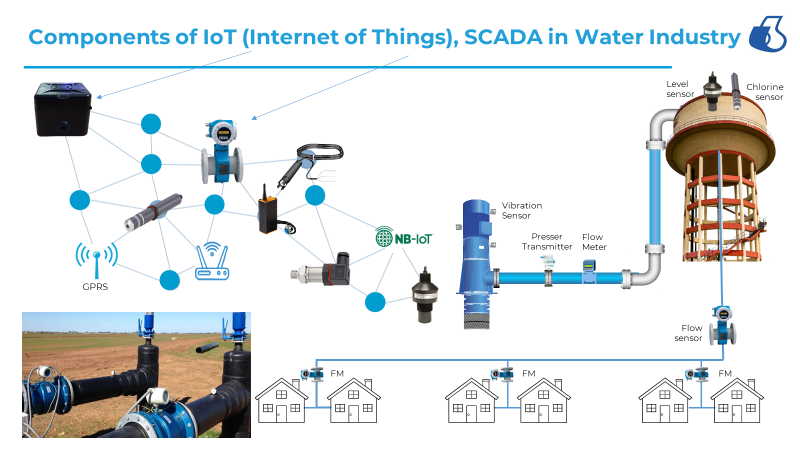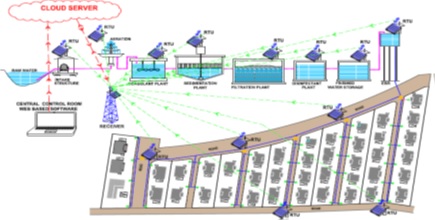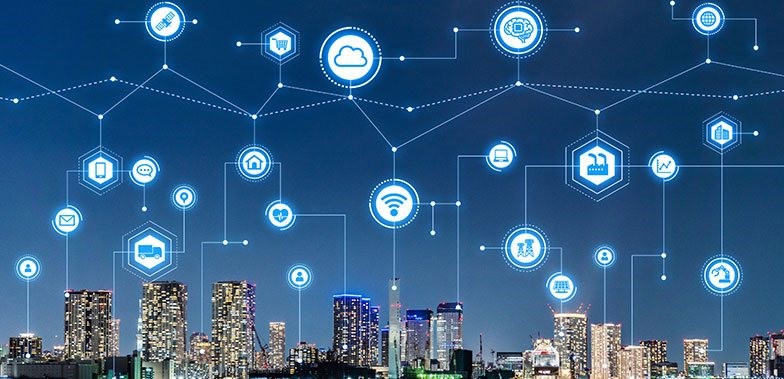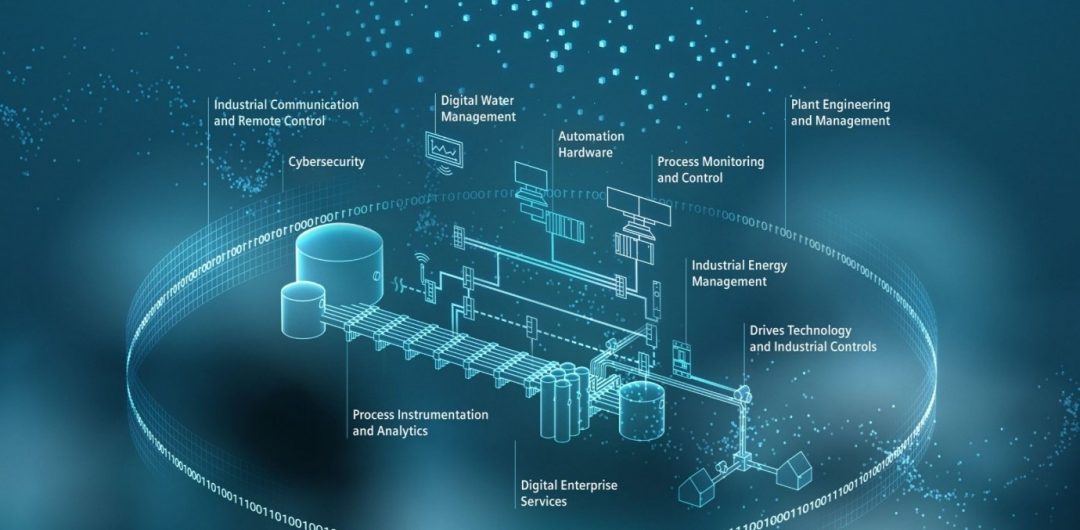By Gaurav Garg, Smart Water Specialist, CIMCON Software India PVT. LTD
The Importance of Urban Water Management
Urban water management is a critical aspect of sustainable development in modern cities. The growing urban population and increasing demand for water resources have put immense pressure on existing water infrastructure. The effective management of water resources in urban areas is essential for ensuring a continuous and reliable water supply for residents, businesses, and industries. Additionally, efficient water management is crucial for environmental sustainability and public health. With the rising challenges posed by climate change and population growth, the need for innovative and effective urban water management solutions has become more pressing than ever.

One of the key challenges in urban water management is the aging infrastructure of water systems in many cities. The deterioration of pipelines and water treatment facilities can lead to water losses, leakages, and contamination. Moreover, the uneven distribution of water resources and the lack of adequate storage and distribution facilities further exacerbate the challenges faced in managing urban water supply. These issues not only contribute to water wastage but also pose significant risks to public health and safety. Therefore, there is an urgent need to address these challenges through innovative technologies and strategies that can revolutionize urban water management.
The integration of advanced sensors and real-time monitoring systems in urban water management has the potential to transform the way water resources are managed in cities. By leveraging sensor technologies, water utilities can gain valuable insights into the condition and performance of their water infrastructure. Real-time data collection and analysis enable proactive maintenance and early detection of leaks, reducing water losses and ensuring the efficient operation of water networks. Furthermore, the integration of sensor data with advanced analytics and modelling tools can facilitate predictive maintenance and optimal resource allocation, leading to improved resilience and sustainability of urban water systems.
Revolutionizing Water Management with Sensor Integration
The integration of sensor technologies in urban water management represents a paradigm shift in the way water resources are monitored and managed. Traditional methods of manual inspection and periodic assessments are often time-consuming and resource-intensive, making it challenging to identify and address issues in a timely manner. In contrast, sensor integration enables continuous, real-time monitoring of various parameters such as water flow, pressure, quality, and temperature. This real-time data empowers water utilities to detect anomalies and potential failures promptly, allowing for proactive interventions and preventive maintenance.
Sensors deployed in water distribution networks and treatment facilities can provide valuable information on the performance and condition of critical infrastructure components. For instance, pressure sensors can detect changes in water pressure levels, indicating potential leaks or bursts in pipelines. Additionally, water quality sensors can monitor the presence of contaminants and ensure compliance with regulatory standards. The use of advanced sensor technologies, such as acoustic and electromagnetic sensors, further enhances the capability to detect leaks and assess the structural integrity of pipelines, reducing the risk of water loss and infrastructure failures.
The integration of sensor data with geographic information systems (GIS) and asset management platforms enables water utilities to visualize and analyze the operational status of their water networks comprehensively. By utilizing real-time data and spatial analytics, utilities can prioritize maintenance activities, optimize resource allocation, and improve the overall resilience of water infrastructure. Furthermore, the implementation of sensor integration can support the development of smart water networks, facilitating the efficient management of water resources and enhancing the responsiveness of utilities to dynamic operational conditions.
Real-Time Monitoring in Water Management
Real-time monitoring systems play a pivotal role in enhancing the efficiency and reliability of urban water management. By continuously collecting and analyzing data from various sensors and monitoring devices, water utilities can gain actionable insights into the performance of their water infrastructure. Real-time monitoring not only enables the early detection of abnormalities and potential failures but also supports the optimization of operational processes and resource management. With the advent of Internet of Things (IoT) technologies, real-time monitoring solutions have become more accessible and scalable, offering unprecedented visibility and control over water systems.

The deployment of real-time monitoring solutions in water management encompasses a wide range of applications, including remote sensing, telemetry, and supervisory control and data acquisition (SCADA) systems. These technologies enable the seamless transmission of data from sensors and monitoring devices to centralized control centers, allowing for instantaneous analysis and decision-making. Furthermore, the integration of real-time data with advanced analytics and machine learning algorithms can facilitate the development of predictive maintenance models, enabling water utilities to anticipate and mitigate potential issues before they escalate into critical failures.
Real-time monitoring also empowers water utilities to respond swiftly to changes in water demand, supply, and quality. By leveraging real-time data, utilities can optimize the operation of water treatment plants, distribution networks, and storage facilities to meet fluctuating demand and ensure water quality compliance. Additionally, real-time monitoring supports the implementation of demand-driven management strategies, enabling utilities to proactively address water distribution challenges and minimize the risk of service disruptions. The ability to monitor water systems in real time provides utilities with the agility and adaptability needed to navigate complex operational scenarios and deliver reliable water services to urban communities.
Benefits of Water Information Management Solutions
Water information management solutions encompass a suite of technologies and tools designed to capture, analyze, and leverage water-related data for informed decision-making and operational optimization. These solutions offer a comprehensive approach to managing water resources, infrastructure, and services, enabling water utilities to enhance their efficiency, resilience, and sustainability. By integrating advanced data management and analytics capabilities, water information management solutions provide a holistic view of water systems, empowering utilities to address challenges and capitalize on opportunities for improvement.

One of the primary benefits of water information management solutions is the ability to centralize and integrate disparate data sources, including sensor data, operational records, customer information, and environmental data. By consolidating and harmonizing diverse data sets, utilities can gain a unified understanding of their water systems and performance metrics, facilitating evidence-based decision-making and strategic planning. Moreover, the integration of data management solutions with geographic information systems (GIS) and enterprise asset management (EAM) platforms enables utilities to visualize and analyse spatial and operational data, supporting efficient resource allocation and infrastructure management.
The application of advanced analytics and modelling tools within water information management solutions enables utilities to derive actionable insights from complex data sets. By leveraging predictive analytics, machine learning, and optimization algorithms, utilities can forecast water demand, identify potential risks, and optimize asset performance. Furthermore, the implementation of real-time data processing and visualization capabilities facilitates the monitoring of key performance indicators (KPIs) and the identification of trends and patterns, enabling utilities to proactively address operational challenges and drive continuous improvement in their water management practices.
Water information management solutions also play a crucial role in enhancing transparency and accountability in water management. By providing stakeholders with access to comprehensive and up-to-date information on water systems and services, utilities can foster greater public trust and engagement. Additionally, the integration of customer relationship management (CRM) functionalities within water information management solutions enables utilities to better understand and respond to customer needs, ultimately improving the overall quality of service delivery.
Implementing Water Network Asset Management Solutions
Water network asset management solutions are instrumental in enabling utilities to optimize the performance and lifespan of their infrastructure assets. These solutions encompass a range of technologies and methodologies aimed at enhancing asset reliability, resilience, and cost-effectiveness. By adopting a proactive approach to asset management, water utilities can minimize the risk of asset failures, optimize maintenance activities, and maximize the value of their investments in water infrastructure. The implementation of asset management solutions is essential for ensuring the long-term sustainability and operability of urban water networks.
One of the key components of water network asset management solutions is the utilization of asset performance monitoring and condition assessment technologies. These tools enable utilities to monitor the health and operational status of critical infrastructure components, such as pipelines, pumps, valves, and treatment facilities. By deploying sensors and monitoring devices, utilities can gather real-time data on asset performance, allowing for early detection of deterioration, defects, and potential failures. This proactive approach to asset condition assessment supports informed decision-making and prioritization of maintenance and rehabilitation efforts.
The integration of asset management solutions with risk assessment and investment planning methodologies enables utilities to develop comprehensive strategies for optimizing their asset portfolios. By conducting risk assessments and life cycle cost analyses, utilities can identify critical assets, evaluate potential vulnerabilities, and prioritize investment and maintenance activities. Furthermore, the implementation of asset performance modeling and predictive analytics supports the development of long-term asset management plans, facilitating the optimization of capital expenditures and the allocation of resources to maximize the reliability and resilience of water infrastructure.
Water network asset management solutions also facilitate compliance with regulatory requirements and industry standards, ensuring that utilities adhere to best practices in asset management and performance optimization. By leveraging asset management software and decision support tools, utilities can streamline regulatory reporting, track asset performance against established benchmarks, and demonstrate accountability in asset stewardship. Additionally, the integration of asset management solutions with enterprise resource planning (ERP) and work order management systems enables utilities to optimize their maintenance workflows and resource utilization, further enhancing the efficiency and effectiveness of asset management practices.
Future Trends in Urban Water Management
One of the key future trends in urban water management is the widespread adoption of Internet of Things (IoT) and sensor technologies to create interconnected and intelligent water networks. The deployment of IoT-enabled sensors throughout water infrastructure will enable utilities to gather real-time data on water flow, pressure, quality, and asset performance, empowering proactive maintenance and resource optimization. These interconnected systems will facilitate the development of smart water networks, capable of adapting to dynamic operational conditions and enhancing the overall reliability and efficiency of urban water supply and distribution.


Another prominent trend in urban water management is the integration of advanced analytics and artificial intelligence (AI) to derive actionable insights from vast volumes of water-related data. By harnessing the power of predictive analytics, machine learning, and optimization algorithms, water utilities can forecast demand patterns, identify potential risks, and optimize asset performance. The use of AI-driven decision support systems will enable utilities to make data-driven and evidence-based decisions, leading to more efficient resource allocation, improved operational resilience, and enhanced service delivery to urban communities.
The Role of Technology in Sustainable Water Management
One of the fundamental contributions of technology to sustainable water management is the ability to optimize water use and distribution through data-driven insights and operational efficiencies. By leveraging sensor integration and real-time monitoring, utilities can detect leaks, reduce water losses, and ensure the efficient operation of water networks. Additionally, the application of advanced analytics and modelling tools enables utilities to forecast water demand, optimize treatment processes, and proactively address operational challenges. These capabilities support the conservation of water resources and the promotion of sustainable water use practices in urban environments.

In addition, technology plays a critical role in promoting public awareness, engagement, and participation in sustainable water management initiatives. By leveraging digital communication platforms and smart metering technologies, utilities can provide consumers with real-time information on their water usage, encourage conservation practices, and foster a culture of responsible water stewardship. Furthermore, the integration of technology with community outreach and education programs enables utilities to empower residents with the knowledge and tools needed to contribute to sustainable water management efforts, ultimately creating a more informed and environmentally conscious society.
Conclusion
In conclusion, CIMCON Software India PVT. LTD plays a crucial role in advancing the transformative journey of urban water management through its cutting-edge solutions. With a commitment to innovation and collaboration, CIMCON contributes significantly to the integration of advanced sensor technologies and data-driven solutions. By leveraging their expertise, cities can harness the power of real-time monitoring, proactive leak detection, and comprehensive asset management.
CIMCON’s role in providing water management solutions and water network asset management tools aligns with the broader technological shift towards sustainable water practices. As cities optimize their water infrastructure, minimize wastage, and make informed decisions, CIMCON’s contributions become integral to achieving the efficiency, resilience, and sustainability goals of urban water systems.
The partnership between technology and urban water management, exemplified by CIMCON, signifies a paradigm shift that empowers cities to overcome challenges and embrace a more sustainable and resilient future. Through this collaboration, CIMCON is instrumental in navigating the complexities of modern water management, paving the way for a future where water resources are managed with confidence and foresight. As cities continue to evolve in their approach, CIMCON’s role remains pivotal in shaping a world where technology and innovation harmonize for the benefit of urban water systems and the communities they serve.





